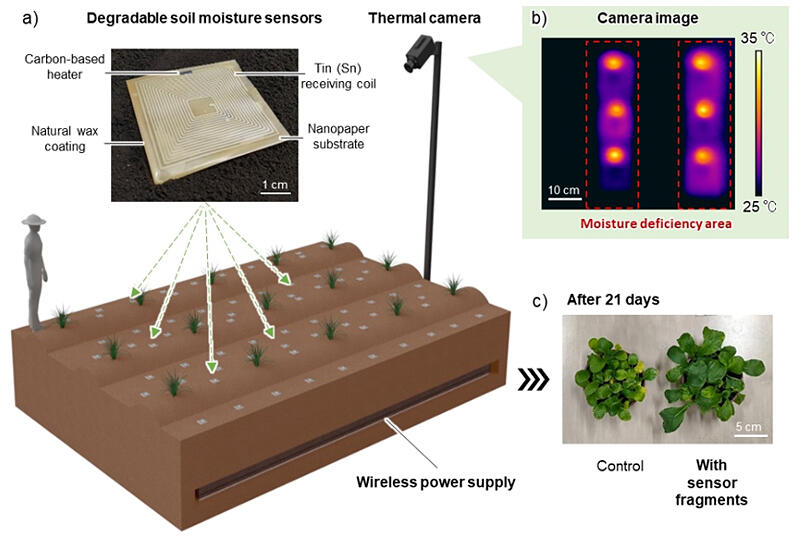A research group led by Assistant Professor Takaaki Kasuga and his colleagues of the Institute of Scientific and Industrial Research (SANKEN) at Osaka University announced that they have developed a soil moisture sensor made largely of environmentally friendly materials such as paper, natural wax, and tin. The developed sensor emits the detected moisture content of the soil as heat. By capturing heat via a thermal camera, it is possible to simultaneously obtain the sensor installation location and soil moisture content remotely. By combining a simplified sensor body, a wireless power supply, and image recognition using a thermal camera, they succeeded in achieving the degradability of the sensor body, sensing functionality, and transmission of data, including data and location information. They expect their methodology to be put into practical use as an environmentally friendly sensing system. The results were published in the international academic journal Advanced Sustainable Systems on October 17.

Credit: 2023 Kasuga et al., Wirelessly powered sensing fertilizer for precision and sustainable agriculture. Advanced Sustainable Systems
The sensor can convert various environmental information − such as temperature, humidity, moisture content, and light − into digital signals. However, when numerous sensors are installed in an outdoor environment, it is difficult to recover them all. Furthermore, conventional sensors are composed of copper and non-degradable petroleum-based plastics, which are prone to damaging plant life and incurring various other adverse environmental effects when they are left in the environment.
Outdoor sensors must achieve three tasks: collecting environmental information (sensing), transmitting sensing data, and transmitting installation location information. The developed sensor body consists of a paper substrate made of wood-derived nanocellulose, tin wiring, a carbon heater, and natural wax coating; the paper substrate and natural wax are biodegraded by microbes. The sensor is equipped with a receiving coil, which is powered by a wireless power supply. The power supply also adds heat to a heater mounted on the sensor. This design ensures that the received power changes depending on the moisture content of the soil where the sensor is installed. As the soil moisture content changes, the temperature of the heater also changes.
If the area where the sensor is installed is photographed with a thermal camera, the location of the sensor can be estimated from that of the heat source, and the soil moisture content can be estimated from the heat source temperature, enabling the immediate detection of areas where soil moisture is insufficient.
The sensors do not need to be collected following their use, as they are eventually biodegraded by microorganisms in the environment. Consequently, they can be installed in high densities in a scattered manner. If the sensor also contains a fertilizer component, it may simultaneously serve as a new 'fertilizer-incorporated' sensor.
Kasuga stated, "We are aiming to achieve a presence similar to fallen leaves, which are everywhere, and blend into nature and circulate. We are developing sensors that can be returned to the soil. For this purpose, we are utilizing naturally existing materials such as cellulose nanofibers (plant fibers) and beeswax. We will tackle each issue individually to achieve practical applicability, including field verification and improvements."
Journal Information
Publication: Advanced Sustainable Systems
Title: Wirelessly Powered Sensing Fertilizer for Precision and Sustainable Agriculture
DOI: 10.1002/adsu.202300314
This article has been translated by JST with permission from The Science News Ltd. (https://sci-news.co.jp/). Unauthorized reproduction of the article and photographs is prohibited.




